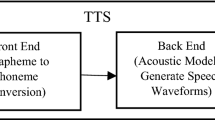Abstract
As development of the speech recognition system entirely depends upon the spoken language used for its development, and the very fact that speech technology is highly language dependent and reverse engineering is not possible, there is an utmost need to develop such systems for Indian languages. In this paper we present the implementation of a time delay neural network system (TDNN) in a modular fashion by exploiting the hidden structure of previously phonetic subcategory network for recognition of Hindi consonants. For the present study we have selected all the Hindi phonemes for srecognition. A vocabulary of 207 Hindi words was designed for the task-specific environment and used as a database. For the recognition of phoneme, a three-layered network was constructed and the network was trained using the back propagation learning algorithm. Experiments were conducted to categorize the Hindi voiced, unvoiced stops, semi vowels, vowels, nasals and fricatives. A close observation of confusion matrix of Hindi stops revealed maximum confusion of retroflex stops with their non-retroflex counterparts.




Similar content being viewed by others
References
Lang KJ, Waibel AH, Hinton GE (1990) A time delay neural network architecture for isolated word recognition. Neural Netw 3:23–43
Lippmann RP (1987) An introduction to computing with neural nets. IEEE ASSP Mag April:8–20
Sarma ASS, Ganesan M, Agrawal SS (1990) Development of speech data base of 200 spoken Hindi words, International workshop on speech technology for man–machine interaction, Bombay, Dec 10–12–1990
Traunmuller H, Lacerda F (1987) Perceptual relativity in identification of two formant-vowels. Speech Commun 6:143–157
Waibel AH, Sawai H, Shikano K(1989) Consonant recognition by modular construction of large phonemic time delay neural networks. ICASSP-89
Author information
Authors and Affiliations
Corresponding author
Rights and permissions
About this article
Cite this article
Dev, A. Effect of retroflex sounds on the recognition of Hindi voiced and unvoiced stops. AI & Soc 23, 603–612 (2009). https://doi.org/10.1007/s00146-008-0179-9
Received:
Accepted:
Published:
Issue Date:
DOI: https://doi.org/10.1007/s00146-008-0179-9




